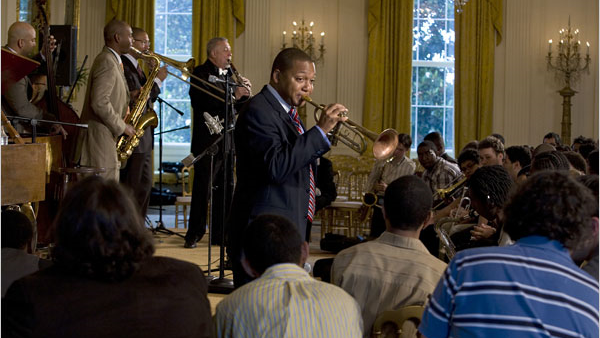At the White House, a Blend of Jazz Greats and Hopefuls

Wynton Marsalis at a White House jazz clinic on Monday hosted by Michelle Obama. Credit Stephen Crowley/The New York Times
WASHINGTON — It was not the full-force, let-a-thousand-saxophones-bloom, this-is-our-music festival that some might have wished from a White House where the language of jazz seems to have a place, at least in the president’s iPod. But it was a good start.
On Monday afternoon, Michelle Obama invited about 150 high school jazz students to the White House for a program called Jazz Studio. There was a student clinic including five members of the Marsalis family and the clarinetist Paquito D’Rivera, and then a short concert introduced by the first lady.
Before some readers begin feeling too righteous, it’s important to know that the event wasn’t a pure, stand-alone expression of love for jazz; it was the first in a series of three very different musical events in the White House this year.
So if the short afternoon event was largely symbolic for those on the sidelines, quickly and easily establishing the notion that the new administration is interested in musical genres other than country, it was a useful, practical event for the students.
The young musicians were divided into three groups of 50, and the workshop themes were “American History and Jazz,” “Syntax of Jazz,” “The Blues Experience and Jazz” and “Duke Ellington and Swing.” Other workshop leaders included the saxophonist Todd Williams, the trumpeter Sean Jones and the pianist Eli Yamin.
Continue reading the main story
The event was organized in conjunction with the Duke Ellington School of the Arts and the Duke Ellington Jazz Festival in Washington, Jazz at Lincoln Center in New York City, the Thelonious Monk Institute of Jazz and several other institutions.
The Marsalises — especially Wynton and his father, Ellis — are born teachers, and, at least during the part of their hourlong clinic that journalists were allowed to watch, they packed important, basic lessons about jazz history and practice into short spaces. The students drank it in, and the teachers beamed.
After the elder Mr. Marsalis talked for a while about individual expression in jazz and the birth of swing rhythm, the students traded 12-bar improvisations with the master musicians on a blues tune. And then Wynton Marsalis doled out bits of advice, without aiming them at particular players. The advice: never slink off looking mad at yourself after your solo, don’t abuse the rhythm section and play shorter.
“The blues forces us to feel vocal elements in our playing,” Mr. Marsalis said, “and it keeps us from going” — here he played a fast, ripping, show-off improvisation that wasn’t vocal at all. “Now, I’m going to play, and Branford is going to imitate.”
The students quickly jumped in. None were virtuosos; some, including a trumpeter from New York, Ivan Rosenberg, were quite good. Perhaps sensing a competitive spirit, Mr. Marsalis pushed Mr. Rosenberg into smeared, highly expressive whines; finally he played a whinnying phrase that trailed into fast, articulated notes. “I can’t do that, man,” Mr. Rosenberg said, laughing and backing off.
Sharing a stage with Wynton Marsalis, who teaches constantly on the road, is not out of the realm of possibility for a gifted young jazz musician. But doing it at the White House can make you starry-eyed.
“That was crazy,” said Phillip Slyde, an able 17-year-old alto saxophonist who played question-and-answer with Mr. D’Rivera. He came up from New Orleans the day before, he said. He was recuperating from nerves, in the expectant hush before Mrs. Obama’s arrival.
Kyle Wedberg, the president of his school, the New Orleans Center for Creative Arts, appeared behind him. “This says that normal, everyday Americans have a place in this White House, versus people that have some leverage to get in here,” Mr. Wedberg said, breathlessly. “We changed 14 lives today. That’s amazing: it’s a great use of this public facility.”
In her four-minute speech, Mrs. Obama brushed across two well-known thoughts about jazz — that it “may be America’s greatest gift to the world” and that “there is no better example of democracy than a jazz ensemble” — but she basically made way for the closing concert, which put Mr. D’Rivera and Mr. Marsalis in front of a young band, including the pianist Tony Madruga and the saxophonist Elijah Easton.
Mr. D’Rivera played embroidered versions of famous jazz melodies on the clarinet, encouraging the student audience to guess their titles and composers. When he played a famous Dizzy Gillespie phrase, the audience — including Mrs. Obama, seated in the front row with her daughters — answered promptly with the correct response: “Salt peanuts, salt peanuts.” “Ahhh!” Mr. D’Rivera shouted, looking extremely pleased. “Michelle knows it!”
By Ben Ratliff
Source: The New York Times


